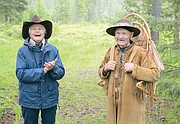Backcountry Horsemen of the Flathead in 50th year
The log would have largely gone unnoticed by any other horse party.
It was across the trail, but easy to step over for a horse, but Greg Shatz said they would remove it anyway.
He explained that removing trees along the trail, even innocuous ones, at lower elevations, made it that much easier for Forest Service trail crews to completely clear a trail later in the season.
On this day, Shatz, his wife Deborah, Ally Pike and Dr. John Andenoro were headed up the Meadow Mountain Trail near Spotted Bear to clear trail.
They’re all members of the Backcountry Horsemen of the Flathead, which is celebrating its 50th year as an organization this year.
Greg Shatz is the treasurer and his wife, Deborah, is the president.
It is the Saturday before Memorial Day and the four of them pull out saws and get to work on the downed tree.
A few minutes with a crosscut saw and the tree is no longer across the trail.
The goal is to keep clearing until they hit snow, which is still miles away and several thousand feet upslope into the Bob Marshall Wilderness.
The purpose of the organization is to perpetuate enjoyable common sense use of horses in the backcountry and assist government agencies in maintenance and management of the resource.
They also educate, encourage and solicit active public participation in wise and sustaining use of horses.
In short, they’re boots, er, hooves on the ground.
They clear trails across hundreds of miles of roadless forest across the region each year, Deborah Shatz notes, most of it on the Flathead National Forest.
The organization got its start out of necessity, Deborah Shatz noted. Back in the early 1970s, horse use had already been prohibited in the Jewel Basin in the Swan Range and there were rumblings to curb, or at least require permits, for horse use in the Bob Marshall Wilderness as well.
The idea for an organization to represent horsepackers in the wilderness came about during a guided hunting trip to Wall Creek, in the middle of the Bob Marshall Wilderness, in 1972, as the founders discussed the proposed regulations.
Present were Roland Cheek, a safety director for Plum Creek Timber who became an outfitter and wrote a column for the Hungry Horse News; Dennis Swift, a forester and planer mill foreman for F.H. Stoltze Land & Lumber Co. who became a guide; and Ken Ausk a longtime packer and horse enthusiast.
“What we really wanted was to alert some already in-place conservation organization to the problem,” Cheek recalled in a 2013 interview with the Hungry Horse News. “What we wound up getting was the realization that ‘the buck stops here.’ Thus we sighed and directed most of our late-night campfire brainstorming to developing a marching plan that would hopefully lead to an effective conservation organization representing horse users.”
The three later were joined by Dulane Fulton, a fellow horseman who had served as principal at Columbia Falls High School and had recently retired as superintendent of School District 6.
Stu Sorenson a longtime packer and wilderness advocate came onboard as did June Burgau.
Keni Hopkins, Ken Ausk’s daughter was in high school at the time the organization was founded. She could type and was pressed into service, typing up the articles of incorporation for the organization as Cheek and her father dictated and then made corrections, behind her.
As it developed, the founders formed an organization that not only promoted a Leave No Trace ethic and practice with horses in the wilderness, it also embraced projects and fostered a cooperative relationship with the Forest Service and other land agencies.
One of the first projects was helping replace a bridge at Big Salmon Creek in the Bob Marshall in 1974. The Forest Service had no funds to replace the bridge and was going to remove it.
The Horsemen stepped up to the plate and were instrumental in replacing the bridge.
Other projects ensued.
“We got out there with the crosscuts saws and started working with the Forest Service,” recalled Burgau, who is still on the board of directors today.
After humble beginnings, there are more than 170 Backcountry Horsemen organizations across the United States today.
The organization is always looking for new members and takes pains to teach them correct stock use in the backcountry.
“So it’s easy on the environment and easy on them,” Sorenson noted.
“Now we know how to go into the backcountry and not leave those impacts,” Deborah Shatz said.
They use simple things like a highline, a tying system, which keep horses from chewing on trees and causing other damage.
The organization also has a youth education program. Greg Shatz is the youth program chair for the Backcountry Horsemen of Montana and the youth committee Chair of the Backcountry Horsemen of America.
He helps chapters across with youth programs and also puts together two youth packing camps in the Bob Marshall each summer, which reaches about 18 youths a year — often from across the U.S.
The future after all is the youth.
“It’s all hands on,” Shatz notes. “They learn how to saddle, they learn how to manty, do panniers, they learn about Leave No Trace, how to set up a camp and trailwork,” he said.
Folks interested in the camps or learning more about the organization can visit its website at https://bchmt.org



